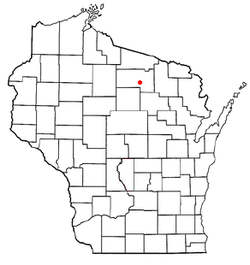Rhinelander, Wisconsin
| Rhinelander, Wisconsin | |
|---|---|
| City | |

Looking east at downtown Rhinelander with view of the Oneida County Courthouse dome
|
|
 Location of Rhinelander, Wisconsin |
|
| Location of city in Wisconsin / United States | |
| Coordinates: 45°38′22″N 89°24′44″W / 45.63944°N 89.41222°WCoordinates: 45°38′22″N 89°24′44″W / 45.63944°N 89.41222°W | |
| Country | United States |
| State | Wisconsin |
| County | Oneida |
| Area | |
| • Total | 8.61 sq mi (22.30 km2) |
| • Land | 8.34 sq mi (21.60 km2) |
| • Water | 0.27 sq mi (0.70 km2) |
| Elevation | 1,549 ft (472 m) |
| Population (2010) | |
| • Total | 7,798 |
| • Estimate (2012) | 7,653 |
| • Density | 935.0/sq mi (361.0/km2) |
| Time zone | Central (CST) (UTC-6) |
| • Summer (DST) | CDT (UTC-5) |
| Zip Code | 54501 |
| Area code(s) | 715 & 534 |
| FIPS code | 55-67200 |
| GNIS feature ID | 1572231 |
| Website | www.ci.rhinelander.wi.gov |
Rhinelander is a city in and the county seat of Oneida County,Wisconsin, United States. The population was 7,798 at the 2010 census.
The area that eventually became the city of Rhinelander was originally called Pelican Rapids by early settlers, named for the stretch of rapids just above the convergence of the Wisconsin and Pelican Rivers. Around 1870, Anderson W. Brown of Stevens Point and Anson P. Vaughn traveled up the Wisconsin River in order to cruise timber for Brown's father, E. D. Brown. Upon arriving at the meeting point of the Wisconsin and Pelican Rivers at the site of John Curran's trading post, and seeing the high banks along the rapids and the excellent pine stands, Anderson Brown envisioned a mill town with a lumber mill powered by the waters of the Wisconsin River. Brown's vision would not come to fruition for some years, however after subsequent expeditions with others including his brother and Rhinelander's first mayor, Webster Brown, the brothers managed to convince their father and uncle to purchase the land from the federal government and build a town. In its charter, the city was named Rhinelander after Frederic W. Rhinelander of New York, who was president of the Milwaukee, Lake Shore & Western Road at the time. This was part of a bid by the Brown brothers to induce the railroad to extend a spur to the location to further their lumbering business. Ultimately, after over ten years of negotiations, the Brown family agreed to convey half their land holdings in the area to the railroad in exchange for a rail line to their future city. In 1882, the railroad line from present-day Monico to Rhinelander was completed, jump starting the development of Rhinelander as the commercial hub of the region.
Rhinelander is located at 45°38′22″N 89°24′44″W / 45.63944°N 89.41222°W (45.639515, -89.412086).
...
Wikipedia


